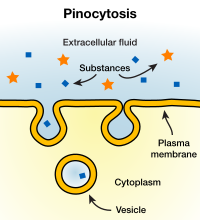
Photo from wikipedia
Controlled buckling of colloidal droplets via acoustic levitation plays an important role in pharmaceutical, coating, and material self-assembly. In this study, the evaporation process of PTFE colloidal droplets with two… Click to show full abstract
Controlled buckling of colloidal droplets via acoustic levitation plays an important role in pharmaceutical, coating, and material self-assembly. In this study, the evaporation process of PTFE colloidal droplets with two particle concentrations (60 wt% and 20 wt%) was investigated under acoustic levitation. We report the occurrence of surface invagination caused by evaporation. For the high particle concentration droplet, the upper surface was invaginated, eventually forming a bowl-shaped structure. While for the low particle concentration droplet, both the upper and lower surfaces of the droplet were invaginated, resulting in a doughnut-like structure. For the acoustically levitated oblate spherical droplet, the dispersant loss at the equatorial area of the droplet is greater than that at the two poles. Therefore, the thickness of the solid shell on the surface of the droplet was not uniform, resulting in invagination at the weaker pole area. Moreover, once the droplet surface was buckling, the hollow cavity on the droplet surface would absorb the sound energy and results in strong positive acoustic radiation pressure at bottom of the invagination, thus further prompting the invagination process.
Journal Title: Nanomaterials
Year Published: 2022
Link to full text (if available)
Share on Social Media: Sign Up to like & get
recommendations!